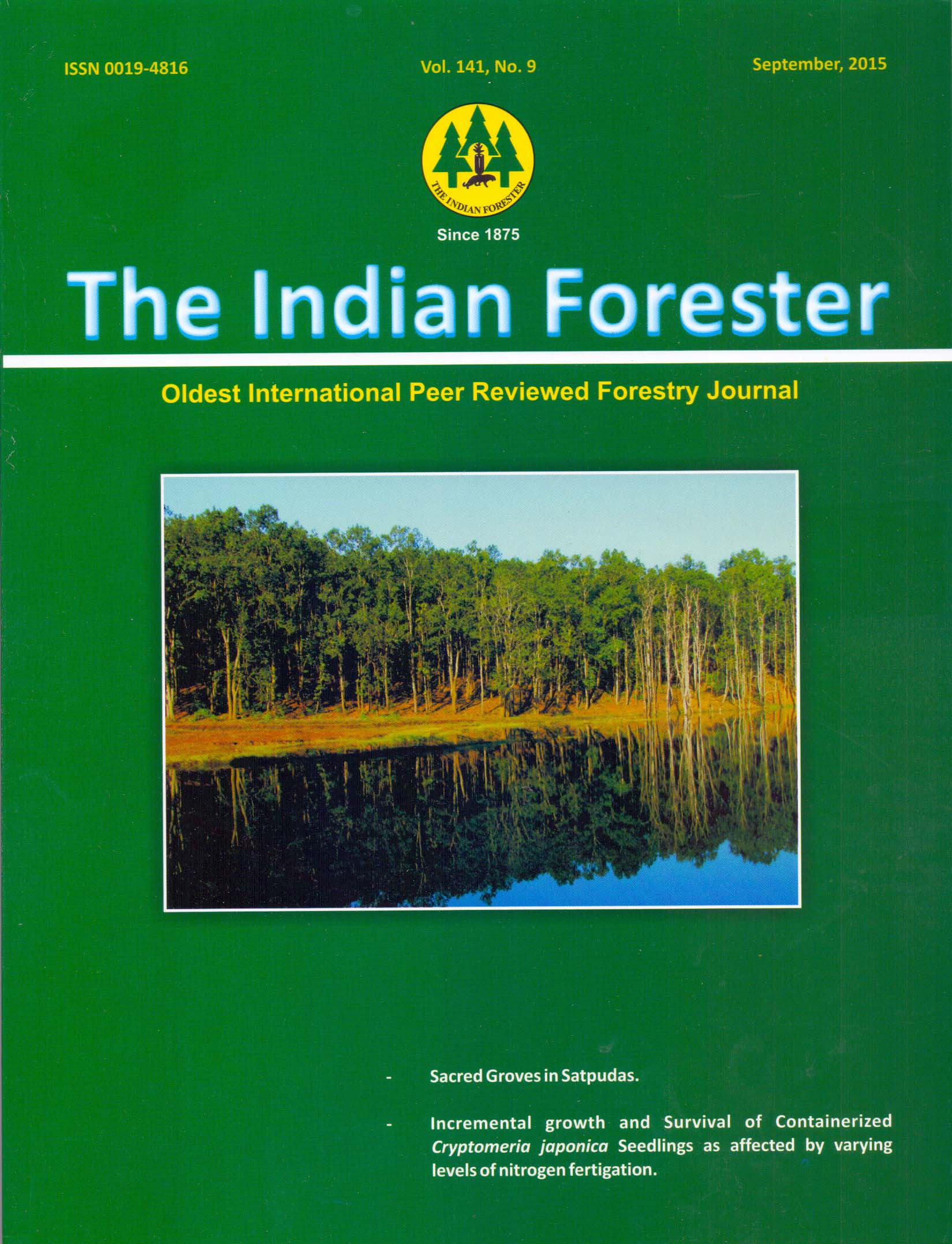Nutritive Value and Cultivation of Pleurotus pulmonarius an Edible Mushroom from Nagaland, India
DOI:
https://doi.org/10.36808/if/2015/v141i9/79860Keywords:
Pleurotus pulmonarius, Edible Mushroom, Nagaland, Mushroom Cultivation.Abstract
The natural occurrence of the edible basidiomycete, Pleurotus pulmonarius is reported for the first time in Nagaland state of India. The mushroom was collected on the dead logs from Puliebezie forest of Kohima. This mushroom is being consumed and sold in local market by the ethnic people of the area. Keeping in view the nutritional value and market demand, cultivation of this species was attempted on paddy straw and the analysis for protein, carbohydrate and fiber contents was also investigated for the cultivated fruit-bodies and results revealed the protein content 37.63%, fat 1.93%, carbohydrate 43.40% and the crude fiber content 4.12%.References
Adhikari M.K., Devkota S. and Tiwari R.D. (2005). Ethnomycolgical knowledge on uses of wild mushrooms in western and central Nepal. Our Nature, 3: 13-19.
Baruah H.K., Sing D.K. and Islam M. (1971). On the distribution of higher Basidiomycetes in the Sibsagar district, Assam. Bulletin Botany Survey India, 13(3&4): 285-289.
Bulakh E.M. (2001). Medicinal Mushrooms of the Russian far east in nature. International Journal Medicinal Mushrooms, 3: 125.
Chang S.T. and Buswell J.A. (1996). Mushroom nutraceuticals. World Journal Microbiol Biotechnol., 12: 473-476.
Choudhury A.U. (2001). Some bird records from Nagaland, north-east India. Forktail, 17: 91-103.
Domondon D.L., He W., Kimpe N.D., Höfte M. and Poppe J. (2004). b-Adenosine, a bioactive compound in grass chaff stimulating mushroom production, Phytochemistry, 65: 181-187.
Fasidi I.O. and Kadiri M. (1993). Effect of sporophores maturity on chemical compoisiton of Volvariella esculenta (Mass) Singer, a Nigerian edible mushroom. Die Nahrung, 37: 269-273.
Harsh N.S.K., Rai B.K. and Ayachi S.S. (1993). Forest fungi and tribal economy-a case study in Baiga tribe of Madhya Pradesh (India). Journal of Tropical Forestry, 9: 270-279.
Kadiri M. and Fasidi I.O. (1990). Variation in chemical composition of Chlorophyllum molybditis (Mayerex Fr) Masses and Pleurotus tuberregium (fries) during fruitbody development. Nigerian J. Sci., 24: 86-89.
Khanna P.K., Bhandari R. and Soni G.L. (1992). Evaluation of Pleurotus spp. for growth, nutritive value and antifungal activity. Indian J. Microbiol., 32: 197-200.
Kumar R., Tapwal A., Pandey S., Borah R.K., Borah D. and Borgohain J. (2013). Macro-fungal diversity and nutrient content of some edible mushrooms of Nagaland, India. Nusantara Bioscience, 5(1): 1-7.
Labarere J. and Menini G.U. (2000). Collection, characterization, conservation and utilization of mushrooms, germplasm resources in Africa. In: The Proceedings of the First International Congress for the Characterization, Conservation, Evaluation and Utilization of Mushroom Genetic Resources for Food and Agriculture. FAO, Bordeaux, France; 9-13, March, 1988.
Lewinsohn D., Wasser S.P., Reshetnikov S.V., Hadar Y. and Nevo E. (2005). Morphological, ecological, and genetic characterization of the Pleurotus eryngii species complex in Israel. International Journal of Medicinal Mushrooms, 7: 429-430.
Lodge D.J., Ammirati F.J., O'Dell E.T. and Mueller M.G. (2004). Collecting and describing macro fungi. In: Biodiversity of Fungi: Inventory and Monitoring Methods. (Mueller, M.G., F.G. Bills and S.M. Foster Eds.). Elsevier Academic Press, Amsterdam, pp: 105-197.
Mueller M.G., Bills F.J. and Foster S.M. (2004). Biodiversity of fungi: inventorying and monitoring methods. Elsevier Academic Press, New York, pp: 128-172.
Parent G. and Thoen D. (1977). Food value of edible mushroom from Upper Shaba region. Economic Bot., 31: 436-445.
Purakasthya R.P. and Chandra A. (1985). Manual of indian edible mushrooms (Today and Tomorrow's Publication, New Delhi), 265-270pp.
Raghuramulu N., Madhavan N.K. and Kalyanasundaram S. (2003). A manual of laboratory techniques. National Institute of Nutrition. Indian Council of Medical Research, Hyderabad, India, pp: 56-58.
Ragunathan R. and Swaminathan K. (2003). Nutritional status of Pleurotus spp. grow on various agro-wastes. Food Chemistry, 80: 371-375.
Ragunathan R., Gurusamy R., Palaniswamy M. and Swaminathan K. (1996). Cultivation of Pleurotus spp. on various agro-residues. Food Chemistry, 55(2): 139-144.
Sanmee R., Dell B., Lumyong P., Izumori K. and Lumyong S. (2003). Nutritive value of popular wild edible mushrooms from northern Thailand. Food Chemistry, 84: 527-532.
Sarma T.C., Sarma, I. and Patiri B.N. (2010). Wild edible mushrooms used by some ethnic tribes of Western Assam. The Bioscan, 3: 613-625.
Shah H., Iqtidar A.K. and Shagufta J. (1997). Nutritional composition and protein quality of Pleurotus mushroom. Sarhad J. Agric., 13: 621-626.
Sing N.I. and Sing S.M. (1993). Edible fleshy fungal flora of Manipur. Bioveel, 4(2): 153-158.
Sing N.I., Sing S.M. and Th C. (2002). Fleshy fungi of Manipur. In: Plant genetic diversity: exploaration, evaluation, conservation, Eds., Vij, S.P., Kondo, K., Sharma, M.L. and Gupta, A. Afficiated East West Press Pvt. Ltd. New Delhi, pp. 9-13.
Stamets P. (2000). Growing gourmet and medicinal mushrooms; 3rd edtn. Ten speed press. Berkeley- Toronto: p 153-167.
Stoller( 1962). Some practical aspects of making mushroom spawn. Mush. Sci., 5: 170-184.
Straatsma G., Ayer F. and Egli S. (2001). Species richness, abundance, and phenology of fungal fruit bodies over 21 years in a Swiss forest plot. Mycol. Res., 105(5): 515-523.
Tanti B., Gurung L. and Sarma G.C. (2011). Wild edible fungal resource used by the ethnic tribes of Nagaland, India. Indian Journal of Traditional Knowledge, 10(3): 512-515.
Downloads
Downloads
Published
How to Cite
Issue
Section
License
Unless otherwise stated, copyright or similar rights in all materials presented on the site, including graphical images, are owned by Indian Forester.





